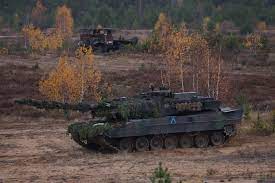Abrams, Leopolds and Provocations

February 20, 2023
The U.S. has joined Germany in supporting Ukraine with battle tanks — Have we gone too far?
On January 25th, Germany — and hours later, the U.S. — pledged to send potent Leopold 2 tanks into the fray, tipping the delicate balance of the war back into Ukraine’s favor. They can use these powerful tanks to recapture Russian-occupied lands, and defend against any Russian attacks come spring. This was not received well in Moscow; the U.S. and Germany were both initially reluctant to send tanks due to their weight, difficulty of operation, and expense. Specifically for the Biden administration, this was a large leap in a series of measured steps for supporting Ukraine.
From the Ukrainian point of view, these tanks were a blessing, albeit a long-requested one. Indeed, “hundreds of ‘thank you[s]’ are not hundreds of tanks,” as Zelenskyy said. Besides their marked improvements in accuracy, potency, and agility when compared to Ukraine’s old T-72 tanks, they also are a quintessential piece in the complex puzzle of large-scale military operation. In chess, coordinating all of your pieces for a queen-side attack is quite challenging, as communication and synchronized, deliberate movements are difficult to master. When making an offensive, the more powerful pieces facilitate the movement of the pawns, the infantry in battle. So is it on the battlefield. The Ukrainians could use the tanks as “an armored brigade,” U.S. army lieutenant Ben Hodges notes, “the spearhead of a force that could break through those Russian defenses down towards Mariupol,” thereby isolating Crimea.
Russia was certainly not happy, but also wasn’t particularly indignant either. Rather, they called the whole ordeal a “losing scheme” that would cost the European taxpayer while not benefitting the Ukrainian military as the tanks would “burn like all the rest.” Russia deemed the newfound support a “blatant provocation,” one it believed would prove futile. It is important to note the importance — and danger — of provocation for the Biden administration.
Throughout most of the war, a similar pattern has followed: Zelenskyy asks the U.S. for large amounts of military support to quell a Russian attack, and the U.S. responds with an offering. This offering, however, comes from a careful calculation from the Biden administration. They need to evaluate how quickly something can be transported, how easy it is to use, and whether it will cause a direct large-scale clash with Russia. The support still manages to prevent an overwhelming Russian advantage, but does this in a minimalist approach. One example of this was in the beginning of the war when Zelenskyy called for rocket launchers, air defense systems, and even an air force protected no-fly zone; the Biden administration evaluated their possibilities with the aforementioned criterion, and decided to send javelins (anti-tank) and stinger (anti-aircraft) missiles. Both of these weapons were very portable, and had a small learning curve, making it easy for Ukrainian soldiers to learn. These made an immediate different in the battle, but would not be able to strike within Russian territory. This prevents further escalation with Russia, a major fear of the U.S.
These Leopold and Abram tanks take this escalation to the next level possibly crossing one of Putin’s red, war-declaring lines. They are extremely powerful and expensive, signaling to Putin the immense dedication of the West to this war. Many have expressed growing fears of nuclear, but this has been avoided for the time being. Still, it is unclear what the spring will bring.

